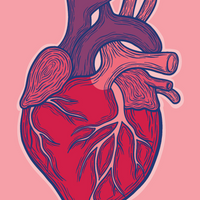ABOVE, © ISTOCK, ALLILLUSTRATIONSAREDRAWNBYME
Early next year, a small clinical trial will begin in Japan, marking the first time reprogrammed stem cells will be deployed to help regenerate injured hearts. A team led by Osaka University cardiac surgeon Yoshiki Sawa will implant sheets—each consisting of 100 million stem-cell derived cardiomyocytes—onto the hearts of three patients with advanced heart failure.
“It’s a big deal they’ve gotten approval to do this,” remarks Jalees Rehman, associate professor of medicine and pharmacology at the University of Illinois at Chicago.
The cardiac study is one of the first few clinical applications of induced pluripotent stem (iPS) cells, the first being an iPS cell-based treatment of macular degeneration of the eye, which also took place in Japan.While it is a big deal to pioneer such a technology clinically, the trial also has its risks, unknowns, and critics.
Japan’s health ministry conditionally approved the heart...
Since the trial was announced, several Japanese researchers have voiced their concerns in comments and correspondences in Nature. One of them, Akira Akayabashi, a professor of biomedical ethics at Tokyo University, notes that the trail participants will receive iPS-derived cells from a donor, instead of from their own tissue, and will have to be placed on immunosuppressants for three months to prevent rejection. “It will add extra burden of using immune suppressants to heart failure patients” who are already suffering, he tells The Scientist.
I’m really happy there are countries in the world that are really prioritizing the role of stem cells.
—Phillip Yang, Stanford University
Sawa says that creating cardiomyocytes derived from a patient’s own cells is not always an option, because the reprogramming process takes a long time. Additionally, providing off-the-shelf treatments is a more feasible route to address heart failure, he says. “Cell therapy [using a patient’s own cells] seems to be not suitable for industrialization,” he says.
While preclinical work with iPS cells has proven effective in improving heart function in mice, pig, and monkey models, it’s not quite clear by which mechanism the cells are promoting muscle regeneration. It’s still unknown whether these cells actually integrate into the heart and become beating heart cells, or whether they just release factors and help existing heart cells, Rehman says.
Sawa’s research in pigs suggests that iPS cell–derived cardiomyocytes promote regeneration of the heart by secreting certain cytokines that stimulate the native heart muscle to grow, he explains. In contrast to skeletal myoblasts taken from patients’ thighs—which he is testing in another clinical trial for heart failure—the cardiac cells derived from iPS cells have “additional cytokines [that] seem to be very helpful,” he tells The Scientist.
See “Mysterious Mechanisms of Cardiac Cell Therapy”
“The use of the cell sheets [in humans] is intriguing,” says Phillip Yang, an associate professor of cardiovascular medicine at Stanford University. “Ultimately, [the procedure] would help find out if this method of application will work or not,” he says. However, if the secretions are what helps repair the heart, he questions why implanting the cells is necessary. Instead, Yang and others are studying potential regenerative therapies by isolating and injecting these regenerative factors into pigs’ hearts.
Yang says he is most concerned with the survival of the reprogrammed cardiomyocytes within the heart. “The likelihood of a cell, a very fragile, iPS-derived cell, surviving in an area where there is a large amount of injury, lack of blood, lack of oxygen supply” is very low, he says. If they disappear quickly, the treatment won’t be effective.
Another concern is that implanting the cells as a sheet will likely involve open-heart surgery. “Because they are making a sheet of cells, they cannot just inject it into the heart,” Rehman says, adding that injecting the cells is a much less invasive approach. And given that the patients are already suffering from severe heart failure, “is the surgery itself going to be a risk for them?” he asks.
There are other risks associated with introducing the new cells into the heart, Rehman says. They could potentially become tumorigenic, because they originate from a very proliferative cell type. The possibility of heart rhythm problems could also be an issue, he says. This became apparent when researchers at the University of Washington injected monkey hearts with cardiomyocytes derived from human embryonic stem cells.
Regardless of the concerns, Yang is excited to see the outcome of Sawa’s trial, and the new information it will bring to the field.
“I’m really happy there are countries in the world that are really prioritizing the role of stem cells,” Yang says. Since stem cell researcher Shinya Yamanaka received the Nobel prize for the development of iPS cells in 2012, the field has been booming in Japan. Four years ago, the Japanese government decided to put more than $1 billion USD towards regenerative medicine research, a quarter of which goes to a project to develop stocks of iPS cells for biomedical research.
“If there was a really effective treatment for heart failure—which is still the number one cause of hospital admission in this country and so forth—I think that would be great,” Yang says. But “whether iPS-derived cardiomyocytes is the answer, and much better than anything else, that I’m not so sure.”
Correction (November 14): A previous version of this article incorrectly stated that this study is the second-ever clinical applications of iPS cells, when it is in fact one of several. The Scientist regrets the error.
Interested in reading more?







